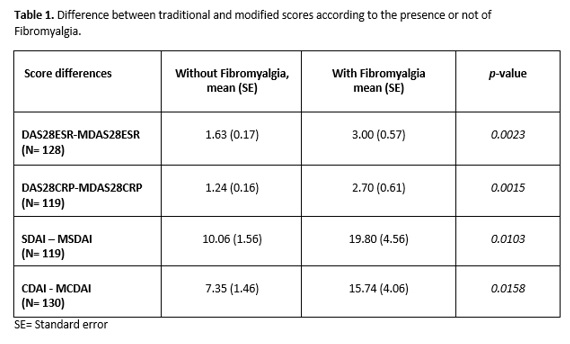Session Information
Date: Monday, November 6, 2017
Session Type: ACR Poster Session B
Session Time: 9:00AM-11:00AM
Background/Purpose: Fibromyalgia has been reported in approximately 20% of Rheumatoid Arthritis (RA) patients. Several studies have shown that the presence of Fibromyalgia (FM) is associated with a significant increase in patient-reported outcomes (PROs). Therefore, traditional composite measures usually employed for the assessment of disease activity in RA, would not be able to discriminate between RA activity and FM symptoms. Baker et al. developed modified disease activity scores based on DAS28, SDAI and CDAI (M-DAS28, M-SDAI, M-CDAI). Interestingly, these scores of which all self-reported measures were excluded, showed a better correlation with synovitis detected on magnetic resonance imaging (MRI). By excluding the tender joint count and the patient’s global assessment of disease activity, these new activity scores would represent a useful tool to better determine RA activity in patients with concomitant FM. The aim of this study was to evaluate the M-DAS28, M-SDAI and M-CDAI performance in a cohort of RA patients with and without concomitant FM. Methods: Cross-sectional observational study that included consecutive patients with diagnosis of RA (ACR/EULAR 2010 criteria) with and without concomitant FM (ACR 1990 and/or ACR 2010 criteria). Other connective tissue disorders (except secondary Sjögren´s Syndrome) were excluded. Demographic and RA characteristics, and disease activity measures were collected. Patients were divided into 2 groups: RA and RA+FM. Statistical analysis: Mean differences between traditional and modified scores in RA patients with and without FM were analyzed. A linear regression model evaluating the effect of FM presence on score difference was performed, adjusting by covariates that proved significant on bivariate analysis. Results: A total of 130 patients were included, 90% women, mean age was 53 years (SD 12.3). Thirty-five patients had RA+FM (27%). Mean duration of RA was 66 months (IQR 23-120). The only difference between the groups with and without FM was the presence of nodular disease (11.4% vs 32.6%, p=0.01). The difference between traditional and modified scores was higher and statistically significant in the RA+FM group (Table 1). This difference remained after adjusting for sex, age and nodular disease (Table 2). Conclusion: RA activity assessed by these new modified disease activity scores in patients with RA and concomitant FM was lower than that measured by traditional ones. Therefore, these new modified scores could avoid a disease activity overestimation in RA patients with FM, resulting in a better tool to achieve the “Treat to Target” premises.
To cite this abstract in AMA style:
Sosa J, Pérez SK, Santa Cruz MJ, Medina MA, Papasidero SB, Klajn D, Caracciolo JA, Correa MDLA, Rolón R, Citera G, Bertolaccini MC, Gonzalez L, Vargas L, Rillo O. M-DAS28, M-SDAI and M-CDAI Performance in a Cohort of RA Patients with and without Concomitant Fibromyalgia [abstract]. Arthritis Rheumatol. 2017; 69 (suppl 10). https://acrabstracts.org/abstract/m-das28-m-sdai-and-m-cdai-performance-in-a-cohort-of-ra-patients-with-and-without-concomitant-fibromyalgia/. Accessed .« Back to 2017 ACR/ARHP Annual Meeting
ACR Meeting Abstracts - https://acrabstracts.org/abstract/m-das28-m-sdai-and-m-cdai-performance-in-a-cohort-of-ra-patients-with-and-without-concomitant-fibromyalgia/


